Google Ads Audience-Based Campaign Restructure Case Study

Google Ads keyword-based campaign structure is one of, if not, the most important aspects of driving paid performance in digital marketing at the highest levels of intent. With bad structure keywords compete against themselves, quality scores plummet, bidding and budgeting become erratic and less predictable, among many other cascading issues. Behind campaign structure (because keywords are king in my opinion), audiences and targeting are the second most important aspect of a successful campaign or marketing strategy in Google Ads. You will not see major success with 1 or the other, you will need both to work with each other to get the most out of your set goals. But what if there was a way to go deeper and get more granular. A way to combine campaign structure and audiences as one to fully understand your audience data sets and how they interact with your keywords.
The Challenge
This what-if is exactly what our account team uncovered as we worked through an interesting scenario for a client. We were tasked with drastically increasing efficiency (ROAS more specifically) in an already strong account and did not want to hurt total revenue in doing so. The account already had a good grasp of the correct keyword structure needed and how they were categorized. What was missing was good audience data and what to do with it.
On our end, we let performance build and compiled what we could, and then the client sent us some demographic profiles to work from. Between these 2 data sets and some more digging, the idea came to fruition: break out campaigns by multiple audience segments rather than layering in audiences into campaigns. Now, this has obviously been done in other accounts before between SKAG strategies or other granularity purists, but we think we have taken it a bit further.
The Solution

Fair Warning: this method was a good amount of up-front work between uploads, build sheets, etc. We took the standard set of product-based campaigns (ads not shopping) and multiplicated them for each gender, age group, country/region that we are advertising in. For example, females between 35-44 in North America, and more specifically, Canada or the US received their own entire campaign with the prior structure. We didn’t create any segmentation outside of the main demographic categories that Google allows and even included Google’s unknown audiences in the restructure (more on this later). Our thoughts were that we could control segments even more than if the audiences were only layered in and controlled by bid modifiers within a campaign. So, did it work?

Oh yeahh, big time. After launching the massive amount if new campaigns, there was an initial learning phase and then we moved into taking action on these campaigns. Between pausing low performing campaign/audience segments, adding in negative keywords to their respective campaigns, and scaling based on the performance we were able to do wonders to the account’s efficiency, especially when tied to a return on ad spend.


Viewing the above stats, we can see that overall traffic and clicks did decrease by roughly 50%, and impressions decreased by up to 77%! However, were any of these apart of the goal I mentioned at the top…? Nope. The metrics that are more in line with efficiency like click-through-rate, revenue-per-click, and our e-commerce conversion rate all rose over 100% with the granular restructure. And the oh-so coveted ROAS increased by 104% which felt like an absolute win for the team. The final detail that deemed this strategy a win was that with all of the decreases in clicks and traffic, revenue did not take a hit, rather it grew – albeit a small amount.
By embarking on this massive restructure and slightly different approach than the typical industry norms, we were able to attain a very granular but controllable state within the account. Even though the up-front work took time to both build and then learn from, our team was able to take these learnings, apply them to the new structure, and rapidly see immense changes in who and where our ads served. We were able to retain the main customer bases’ purchasing power while cutting away the slop, which can be then reattributed to another platform or strategy.
I hope this small case study of an account restructure has been helpful with your accounts and the strategies implemented in them. Shameless plug time, if you found this post helpful please go check out Zach Bruner’s detailed PPC Hero post about tough questions during great PPC performance. Lastly, I mentioned that I would revisit a topic around the mid-way point of this post – unknown audiences in Google Ads. Our Hanapin/Brainlabs colleague John Williams uncovered a crafty way to actually see who lies within these unknown groupings via Google Analytics which is detailed in his LinkedIn post.



